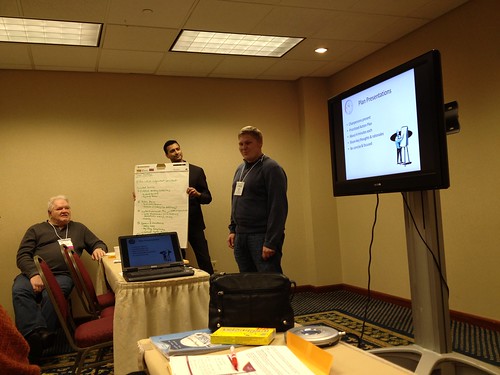And here we are already at the third full day of the conference. Today I started out in the exhibit hall talking to folks as they walked by the booth where we had a display of the #watercon Tweets. But I didn't have much time to chat before having to run off to the Mission Impossible session. As soon as I walked in the door and was handed a sealed envelope marked "Confidential," I realized this would be no ordinary activity. Upon opening the envelope, I discovered I had been assigned to a task force to determine five action points to address signficant water-related deficiencies in a community. Fortunately I was not alone in this endeavor – there were three other water professionals on my team who were obviously very experienced. It didn't take long for us to develop our recommendations. There were three other teams in the room working on the same assignment, and when we were all done, the moderators had us share our ideas. It was interesting to see that all the teams had come up with similar approaches. Well except our team had not thought of calling the National Guard. But, hey, as the one participant pointed out – they are there and available to help so why not use them. Afterwards we were all rewarded with candy for undertaking such a challenging assignment.
After we were released from our task force, I managed to catch the session on Green Infrastructure. While I could not live blog it, I did manage to share a few key points through Twitter (look for the #watercon hashtag to see the stream). The overall message from the panel of speakers is that green infrastructure is made up of complex elements. Designers are still figuring things out – particularly costs. And even though we have the International BMP Database, they cautioned trying to implement someone else's solution for your project without giving careful consideration to local conditions and factors. And finally they pointed out the operation and maintenance and monitoring of BMPs can be expensive.
Later in the afternoon, I caught the following sessions and was able to live blog them. Follow the link to run the CoverItLive tool to see the main points:
Who, What, When, Where and Why of Backflow Prevention – this was also a panel discussion about cross connections and backflow protection. It was interesting to hear the approaches and ideas from each community. Several members from the audience shared their experiences too. Make sure to run the live blog tool to see the tips and advice.
The New World of SCADA Security – this session provided an interesting view of why our operations had not experienced control security issues in the past and why they are more vulnerable now. The main point was "security through obscurity." Until 2010, hackers didn't really know about PLCs or how they operated. But because several programmers got together and wrote a program to hack into a PLC, launched it on another country's operations, and had their program picked up by someone whose actions led to the eventual release of it on the Internet, now anyone can get the code. Great.
I didn't really get a chance to talk to many vendors today – the booths had to be taken down at noon. Tomorrow is the awards breakfast and a few legislative sessions. But because I have some commitments at home, I unfortunately won't be able to attend. So I guess this wraps up my summary of WATERCON, but remember, since we captured so much of it online, you can always access the information by visiting the #watercon Tweets and reviewing the live blog sessions.
I very much appreciate ISAWWA sponsoring my registration and look forward to seeing everyone back next year!



